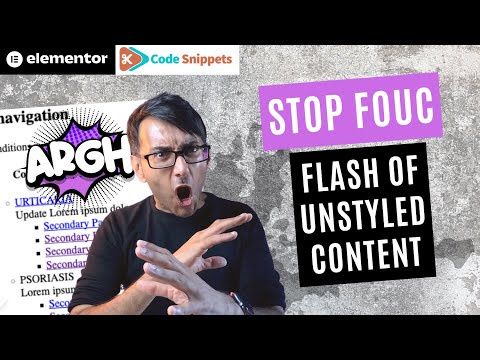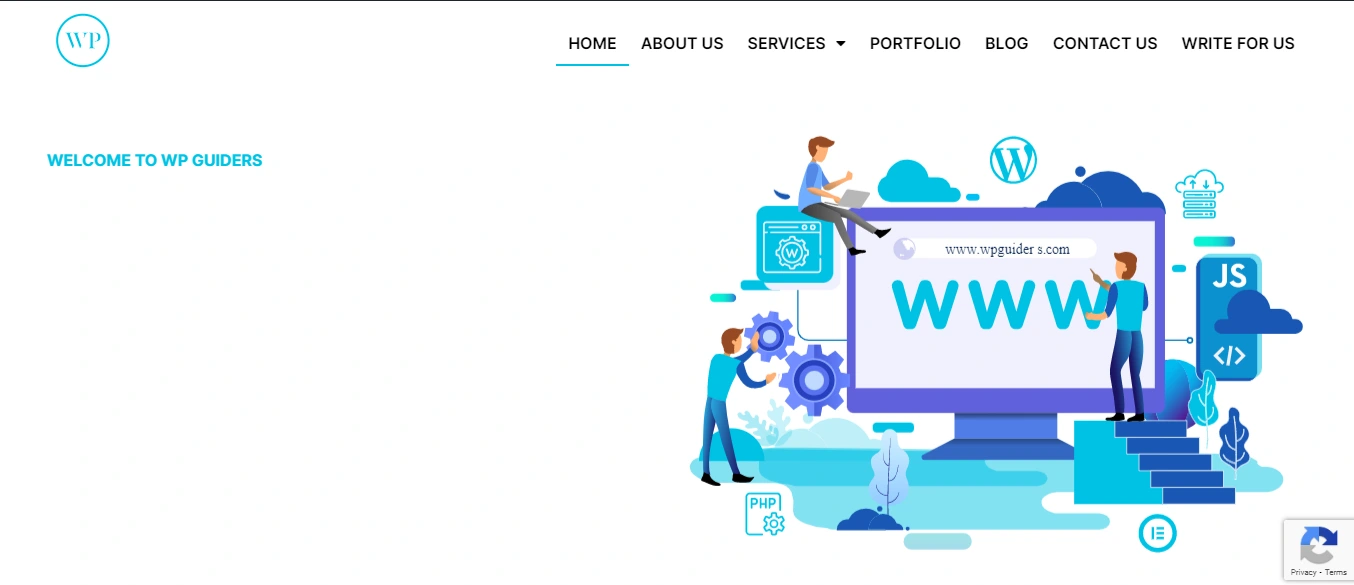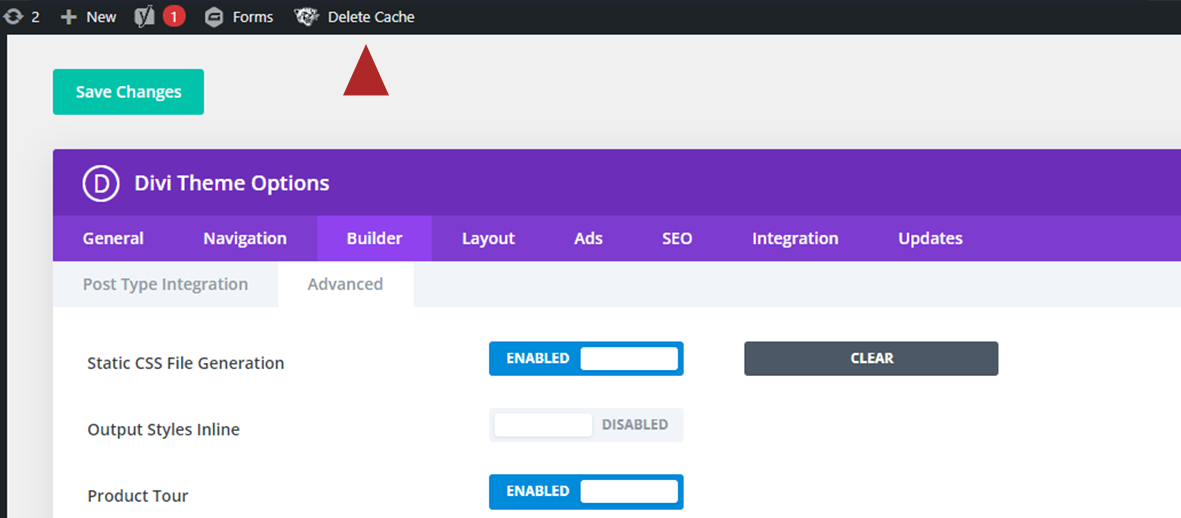Flash Of Unstyled Content
What is Flash of Unstyled Content (FOUC)?
Flash of Unstyled Content (FOUC) occurs when the HTML content of a webpage is rendered by the browser before the associated CSS is fully loaded and applied. As a result, users may briefly see the unstyled version of the webpage, which can look unprofessional and visually jarring. FOUC is more likely to happen when the CSS files are loaded asynchronously or placed at the end of the HTML document.
Causes of Flash of Unstyled Content
Several factors can contribute to FOUC:
1. Slow network connection: If the CSS files take longer to download due to a slow network connection, the browser may start rendering the HTML content before it receives the CSS, leading to FOUC.
2. Render-blocking CSS: When CSS files are render-blocking, meaning they prevent the rendering of the HTML content until they are fully loaded, FOUC can occur.
3. Large CSS files: If the CSS files are large in size, it may take longer for them to download, resulting in a delay in styling the HTML content.
4. Dependencies on external resources: If the webpage relies on external resources, such as fonts or third-party scripts, that are slow to load, FOUC can occur.
Impacts of Flash of Unstyled Content on User Experience
FOUC can have several negative impacts on user experience:
1. Visual inconsistency: Seeing the unstyled version of a webpage can create visual inconsistency and make the website appear unfinished or unprofessional, affecting the overall perception of the brand or organization.
2. Confusion and frustration: Users may find it confusing and frustrating when the content they are viewing suddenly changes appearance, especially if they have already started interacting with the page.
3. Accessibility issues: FOUC can also present accessibility issues, particularly for users with visual impairments who may rely on screen readers or assistive technologies to navigate the webpage. The unstyled content may not be accessible or understandable to them.
Methods to Avoid Flash of Unstyled Content
To avoid FOUC and provide a seamless user experience, consider the following methods:
1. Inline critical CSS: Inline critical CSS directly into the HTML document to ensure it is immediately available, allowing the browser to render the HTML content with the essential styles. This prevents the unstyled content from being displayed.
2. Load CSS asynchronously: Instead of blocking the rendering of the HTML content, load non-critical CSS files asynchronously. This allows the browser to display the content while the CSS files are downloaded in the background.
3. Use browser caching: Implement browser caching techniques to store and reuse previously downloaded CSS files. This reduces the need for repeated downloads and speeds up the overall loading time, minimizing the chances of FOUC.
4. Optimize CSS delivery: Minify and compress CSS files to reduce their file size and optimize delivery. This helps to speed up the download process and ensure that styles are applied quickly.
Best Practices for Handling Flash of Unstyled Content
To effectively handle FOUC, consider the following best practices:
1. Prioritize above-the-fold content: Identify the critical content that is visible above the fold (the portion of the webpage visible without scrolling) and ensure that its associated CSS is loaded and applied first. This reduces the likelihood of unstyled content being displayed in the most prominent area of the webpage.
2. Provide fallback styles: Define fallback styles or defaults directly within the HTML document to ensure that there is a consistent look for the webpage even before the CSS is loaded.
3. Optimize server response time: Improve server response time by utilizing caching, optimizing database queries, and reducing the size of server responses. This helps to ensure that the CSS files are delivered quickly and efficiently.
4. Use a preloader or skeleton screen: Display a preloader or skeleton screen while the page content is being loaded. This creates anticipation and informs users that the webpage is still loading, providing a better user experience during the loading process.
Tools and Techniques to Identify and Mitigate Flash of Unstyled Content
There are several tools and techniques available to identify and mitigate FOUC:
1. Google Chrome DevTools: The Performance and Network tabs in Google Chrome DevTools can help identify whether FOUC is occurring and provide insights into the loading sequence of resources. It allows you to analyze the timeline and diagnose any performance issues causing FOUC.
2. Lighthouse: Lighthouse, a tool built into Google Chrome DevTools, provides an audit specifically for FOUC issues. It can help identify any areas of improvement and suggest optimizations to mitigate FOUC.
3. CSS delivery optimization tools: Tools such as Critical CSS, PurgeCSS, and Penthouse can help optimize CSS delivery by extracting critical CSS and inline or asynchronously load it. They analyze your project’s code and generate optimized CSS to prevent FOUC.
Case Studies and Examples of Flash of Unstyled Content
1. Flash of Unstyled Content in Next.js: Next.js, a popular JavaScript framework, provides Server-Side Rendering (SSR) capabilities. However, if the CSS is not properly handled, FOUC can occur during the server-side rendering process. To mitigate this, Next.js recommends using the `styled-jsx` library, which allows you to write scoped CSS directly within your components.
2. CSS content text flash of unstyled content: This is a specific type of FOUC that occurs when the rendered HTML content contains text without any styling applied. It can happen when the CSS files are not loaded or applied correctly. By following the aforementioned best practices and techniques, you can minimize or eliminate the occurrence of this particular type of FOUC.
In conclusion, Flash of Unstyled Content (FOUC) can have a detrimental impact on user experience by temporarily displaying unstyled content before the CSS styles are applied. By understanding the causes of FOUC, implementing methods to avoid it, following best practices for handling FOUC, and utilizing pertinent tools and techniques, you can create a seamless experience for users, ensuring that your webpages are visually consistent and fully styled from the moment they are displayed.
FAQs:
Q: Is Flash of Unstyled Content only related to CSS?
A: No, Flash of Unstyled Content (FOUC) specifically refers to the display of HTML content in its unstyled form before the associated CSS files are loaded and applied. However, FOUC can occur due to various factors, including the rendering of other resources such as fonts or third-party scripts.
Q: Can FOUC impact SEO?
A: While FOUC itself does not directly impact SEO, it can indirectly affect user experience, which is a factor search engines consider in their rankings. If users have a poor experience due to FOUC, it may lead to higher bounce rates and negatively impact the overall website performance.
Q: Does FOUC only occur on slow connections?
A: No, while slow network connections can increase the likelihood of FOUC, it can happen on any type of connection. Factors such as render-blocking CSS, large CSS files, or dependencies on external resources can contribute to FOUC even on fast connections.
Stop Fouc – Flash Of Unstyled Content – Elementor WordPress Tutorial
Keywords searched by users: flash of unstyled content Flash of unstyled content NextJS, CSS content text
Categories: Top 83 Flash Of Unstyled Content
See more here: nhanvietluanvan.com
Flash Of Unstyled Content Nextjs
Introduction:
Next.js is a popular framework for building server-rendered React applications. It offers several advantages, such as server-side rendering, automatic code splitting, and built-in routing. However, one common issue that developers might encounter while using Next.js is the Flash of Unstyled Content (FOUC). In this article, we will delve into what FOUC is, why it occurs in Next.js, and how to address it effectively.
Understanding FOUC:
FOUC refers to a brief moment when the browser displays a webpage’s content without the necessary styles applied. This phenomenon usually occurs when the browser has parsed and rendered the HTML, but the required CSS files haven’t finished downloading or processing. Consequently, the page appears unstyled for a fraction of a second until the CSS is loaded and applied.
Why FOUC Occurs in Next.js:
Next.js leverages code splitting to improve site performance by only loading the code necessary for the current page. With code splitting, React components, and the associated styles are bundled independently. When a user navigates to a new page, Next.js only loads the required components and their styles. However, this dynamic loading process can lead to FOUC, as the styles might not be immediately available when the page is rendered.
Solutions to Prevent FOUC in Next.js:
Luckily, Next.js provides several solutions to mitigate FOUC. Developers can choose the approach that best suits their project’s requirements:
1. Inline Critical Styles:
Next.js offers a feature called “Inline SSG” (Static Site Generation) that allows developers to generate static HTML with inline styles. By inlining critical styles, the browser can instantly apply them to the rendered HTML, thereby preventing FOUC. However, this technique might lead to larger HTML payloads, affecting performance and possibly increasing maintenance overhead.
2. Head Component:
Next.js provides a built-in Head component, which allows modifying the HTML head tag. By leveraging this component, developers can include inline styles or link style sheets directly in the head tag. This ensures that the styles are applied before the content is rendered, effectively fixing FOUC.
3. CSS-in-JS Libraries:
Using CSS-in-JS libraries, such as styled-components or Emotion, can help address FOUC. These libraries enable developers to write CSS within JavaScript files and dynamically insert the styles based on the rendered components. By inline styling or injecting styles strategically, FOUC can be prevented.
4. Loading Stylesheets Asynchronously:
Another technique to tackle FOUC is to load stylesheets asynchronously. By loading the stylesheets after the page has been rendered, the content appears instantly, even if the styles are still being fetched. Once the CSS is loaded, it is dynamically applied, eliminating FOUC. Libraries like loadCSS or dynamically importing stylesheets can assist in implementing this approach.
FAQs:
1. How does FOUC impact user experience?
FOUC creates a jarring experience for users, where they briefly see unstyled content before the styles are applied. This can leave a negative impression and impact the perceived performance of the website.
2. Does FOUC only occur in Next.js?
No, FOUC is not exclusive to Next.js. Any web page that loads CSS after the content can potentially experience FOUC. However, Next.js, with its code splitting mechanism, increases the chances of FOUC if proper mitigations are not in place.
3. Are there any downsides to inline critical styles?
While inlining critical styles prevents FOUC, it may lead to larger HTML payloads. This can impact page load times, especially on slower connections. Additionally, maintaining and updating inline styles across multiple pages can be challenging.
4. Are there any performance considerations when addressing FOUC?
Indeed, when selecting a solution to tackle FOUC, it is crucial to consider the impact on performance. Techniques like inline critical styles or loading stylesheets asynchronously may introduce additional overhead, affecting both load times and the overall user experience.
Conclusion:
FOUC can significantly impact the user experience by momentarily displaying unstyled content. In Next.js, this issue can arise due to its code splitting mechanism. However, by employing techniques like inline critical styles, the Head component, CSS-in-JS libraries, or asynchronous stylesheet loading, developers can effectively resolve FOUC and ensure a seamless and visually appealing user experience. Remember to carefully consider the trade-offs between different solutions and select one that aligns with the project’s requirements and performance considerations.
Css Content Text
CSS, short for Cascading Style Sheets, is a powerful tool that allows web developers to control the appearance and layout of a website. One important aspect of CSS is the ability to manipulate text content, giving developers the freedom to create visually appealing and dynamic web pages. In this article, we will explore various techniques and properties related to CSS content text, along with some frequently asked questions.
Understanding the Basics of CSS Content Text:
At its core, CSS content text is used to control the styling and positioning of text within HTML elements. Whether you want to change the color, size, font, or spacing of the text, CSS provides a wide range of options to achieve your desired design. To apply CSS styles to text, you need to identify the specific HTML element or class selector associated with the text content.
CSS Properties for Text Styling:
CSS offers a plethora of properties to style text content. Some commonly used properties include:
1. color: This property sets the color of the text. You can specify colors in various formats such as named colors, hexadecimal, RGB, or HSL color codes.
2. font-size: This property controls the size of the text. Values can be defined in pixels, ems, or percentages.
3. font-family: This property defines the font of the text. You can choose from a wide array of fonts or specify a fallback font in case the desired font is not available.
4. font-weight: This property determines the boldness of the text. You can set it to values such as normal, bold, or use numeric values from 100 to 900 for finer control.
5. text-decoration: This property adds visual effects to the text, such as underline, overline, line-through, or none to remove any decoration.
6. text-align: This property sets the horizontal alignment of the text within its container. Options include left, right, center, or justify.
Enhancing Text Appearance with CSS Pseudo-elements:
CSS pseudo-elements like ::before and ::after can be used to add extra elements before or after the content of an element. By utilizing these pseudo-elements, you can insert decorative elements, icons, or even generated content, enhancing the visual presentation of the text.
Controlling Text Layout and Spacing:
CSS provides several properties to control text layout and spacing, resulting in better readability and visual appeal. Let’s explore a few key properties:
1. line-height: This property sets the spacing between lines of text. By adjusting this value, you can improve readability and control the vertical rhythm of the text.
2. letter-spacing: This property adds or reduces space between characters. It can be used to achieve a more condensed or spaced-out appearance.
3. word-spacing: This property controls the spacing between words. Similar to letter-spacing, it allows for adjustments to improve the visual presentation.
4. text-indent: This property specifies the indentation of the first line of text within a block element. It is commonly used for paragraphs or lists to enhance readability.
Frequently Asked Questions:
Q1. Can I apply different styles to specific words within a paragraph?
Yes, you can achieve this by wrapping the desired word(s) in a span element and assigning a unique class or ID to it. Then, you can target that class or ID in your CSS to style the specific word(s).
Q2. How can I align text vertically within an element?
Vertical alignment of text can be achieved by setting the line-height property of the container element equal to its height. This will vertically center the text inside the element.
Q3. Can I use CSS to create drop caps or special text effects?
Certainly! CSS offers a wide range of tools to create drop caps, apply gradients, shadows, or animations to text. By using pseudo-elements or advanced CSS techniques, you can accomplish various visual effects.
Q4. What happens if the specified font in CSS is not available on the user’s computer?
In such cases, the browser will use a fallback font specified in the CSS or default to the browser’s default font settings. It’s important to specify multiple font choices in the font-family property to provide a fallback option.
Q5. Can I import custom fonts using CSS?
Yes, CSS provides the @font-face rule, which allows you to import custom fonts and use them in your web pages. You can link custom font files or use web font services to add a unique touch to your text.
In conclusion, CSS content text plays a crucial role in web development, enabling designers to create visually stunning and engaging websites. By proficiently utilizing CSS properties, pseudo-elements, and understanding various text-related techniques, you can take your web design skills to new heights.
Images related to the topic flash of unstyled content

Found 16 images related to flash of unstyled content theme














![bug-2420]Flash of unstyled or out of date content - Ignition - Inductive Automation Forum Bug-2420]Flash Of Unstyled Or Out Of Date Content - Ignition - Inductive Automation Forum](https://global.discourse-cdn.com/business4/uploads/inductiveautomation/original/3X/9/6/961f277c575e3712f4b305f5fcda8d25883f741e.png)

![LPS-105457] Flash of unstyled content while welcome page loads - Jira Lps-105457] Flash Of Unstyled Content While Welcome Page Loads - Jira](https://avatar-management--avatars.us-west-2.prod.public.atl-paas.net/initials/GH-0.png)
![Firefox drupal login form causing flash of unstyled content [#2900908] | Drupal.org Firefox Drupal Login Form Causing Flash Of Unstyled Content [#2900908] | Drupal.Org](https://www.drupal.org/files/issues/example_flashing_issue_bartik.gif)









Article link: flash of unstyled content.
Learn more about the topic flash of unstyled content.
- Eliminate flash of unstyled content – css – Stack Overflow
- What the FOUC is happening: Flash of Unstyled Content
- Flash of unstyled content – Wikipedia
- How to get rid of the Flash Of Unstyled Content – Medium
- flash of unstyled content (fouc) là gì? cách khắc phục – cometech
- Tips to Resolve FOUC (Flash of Unstyled Content)
- Getting flash of unstyled content (FOUC) with styled-components
- FOUC định nghĩa: Đèn flash nội dung Unstyled
- Avoiding Flash of Unstyled Content (FOUC) with gatsby-ssr.js
See more: https://nhanvietluanvan.com/luat-hoc